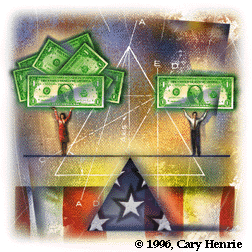


Pinning down who will pay more for a flat tax can seem like a financial shell game, but ask a typical middle-class flat-taxer who should pay more and the answer is usually quick: the rich, because they don't bear their fair share.
Not so fast, say tax experts. First, despite all those loopholes, the rich already pay more, in both absolute dollars and income percentage. Second, many think fairness lies in the eye of the beholder, not economic theory.
One concept of fairness is a proportional tax-the same percentage of income from rich and poor alike. U.S. income taxes, though, have always been progressive, meaning that higher earners pay a higher fraction. Usually much higher: According to economics Nobel laureate Merton Miller, the GSB's Robert R. McCormick distinguished service professor emeritus, the heavy, steeply graduated rates that played midwife to the New Deal--"partly for revenue reasons," he says, "partly for class-warfare reasons"--set the pattern for income tax until the 1980s, when Reagan chopped the top rate from 70 to 28 percent. (Since then, tax rates have crept up; they now range from 15 to 39.6 percent.)
Reagan was hardly the first to question Depression-era notions of equity and economics. In fact, says Miller, "the counterattack began here" at Chicago-led by the Law School's Walter J. Blum, AB'39, JD'41, and Harry Kalven, Jr., AB'35, JD'38, who in 1953 published The Uneasy Case for Progressive Taxation. Limited progressivity still holds sway over most academics, but Elizabeth Garrett believes "average Americans" aren't buying it anymore: "Fairness is now seen as proportional tax-'Everyone ought to pay 10 percent.'"
If that's true, many flat-tax supporters are due for a jolt: The Armey, Forbes, and Hall-Rabushka plans are progressive, thanks to their exemptions. "People are very confused about that," Sherwin Rosen chuckles. For example: If a 10-percent flat tax exempted the first $10,000, then individuals making $20,000 would owe tax on half their income. Their average rate, then, is just 5 percent. At the $100,000 level, the taxable portion is $90,000; the IRS keeps $9,000 or an average rate of 9 percent.
So the flat tax may not deliver the type of proportional fairness that Garrett claims Americans want. But in the big picture, remarkably, a change may be unnecessary. Raaj Sah, a professor at the Harris Graduate School of Public Policy Studies, notes that the total payment from all taxes is already "more or less flat" across income levels, "even though the proscribed structure is progressive." The poor, for instance, cede a bigger share of their income to sales taxes; Social Security hits hard at the lower middle class; and income tax nips hungrily at the well-heeled. For Sah, that raises a troubling question: "If the federal tax schedule were made flat, would the actual payment become regressive"-meaning that poorer people would pay the highest percentages? "No one," he warns, "knows the answer."
 The University of Chicago Magazine April 1996
The University of Chicago Magazine April 1996